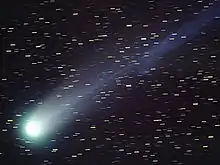| Discovery | |
|---|---|
| Discovered by | Juan G. Sanguin |
| Discovery date | October 15, 1977 |
| Orbital characteristics | |
| Epoch | November 17, 2014 |
| Number of observations | 896 |
| Aphelion | 8.89 AU |
| Perihelion | 1.82 AU |
| Semi-major axis | 5.36 AU |
| Eccentricity | .659521857266038 |
| Orbital period | 12 years |
| Inclination | 19.44339335368171 |
| Last perihelion | 2015-Mar-01 2002-Sep-23 |
| Next perihelion | 2027-July-15[1] |
| TJupiter | 2.410 |
| Physical characteristics | |
| Dimensions | 2.38 km |
| Comet total magnitude (M1) | 10.5 |
92P/Sanguin, also called Sanguin's Comet or Comet Sanguin, is a Jupiter-family comet discovered on October 15, 1977, by Juan G. Sanguin at Leoncito Astronomical Complex. It completes a single rotation approximately every 6 days.[2]
The nucleus of the comet has a radius of about 1.2 kilometers based on observations by Keck, assuming a geometric albedo of 0.04.[3]
References
- ↑ MPC
- ↑ Snodgrass; et al. (June 25, 2011). "The nuclei of comets 7P/Pons-Winnecke, 14P/Wolf and 92P/Sanguin". Astronomy & Astrophysics. 444: 287–295. arXiv:astro-ph/0509115. doi:10.1051/0004-6361:20053237. S2CID 119473563.
- ↑ Meech, K.J.; Hainaut, O.R.; Marsden, B.G. (August 2004). "Comet nucleus size distributions from HST and Keck telescopes". Icarus. 170 (2): 463–491. Bibcode:2004Icar..170..463M. doi:10.1016/j.icarus.2004.03.014.
External links
This article is issued from Wikipedia. The text is licensed under Creative Commons - Attribution - Sharealike. Additional terms may apply for the media files.

.png.webp)